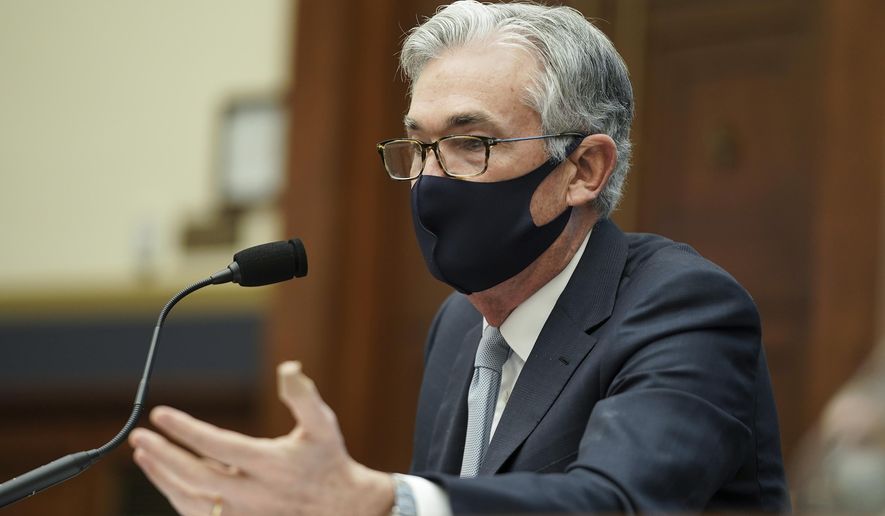OPINION:
Inflation may soon rear its ugly head, and President Joseph R. Biden and Federal Reserve Chairman Jerome Powell will find it more difficult to control than their spending plans and recent ruminations indicate.
In a crisis, spending, borrowing and printing money are fine — as long as those are temporary, and we reckon with the long-term consequences for government finances.
In 2020, Congress and President Trump borrowed to spend about $3.3 trillion to lift family incomes, boost unemployment benefits and support businesses impacted by the shutdowns, but the new Treasury securities were not much scooped up by private investors.
The Fed printed money to expand its holdings of Treasuries by $2.4 trillion, and its overall balance sheet by $3.2 trillion.
The $900 billion authorized in the closing days of the Trump administration, the additional $1.9 trillion proposed by Mr. Biden and his other priorities will require printing even more money in 2021.
Very little of this will be backed by new productive assets or a larger economy — real GDP will not rebound to pre-pandemic levels much before early 2022.
Economists will tell you — or at least those not seeking a job in the new administration or favor among social justice cheerleaders in Congress, the mainstream media and academia — a lot more money chasing a fixed amount of goods should mean more inflation.
In 2020, we were hardly at risk for two reasons. We weren’t anywhere near full employment, and workers and businesses were reluctant to demand substantially higher wages and prices. And much of the Fed’s newly printed money wasn’t getting into circulation in markets for real goods and services.
If they were not among the unemployed or laid idle by COVID-19, consumers used much of their stimulus payments to shore up savings and pay down debt. Households have long planning horizons and like to spread out income windfalls over many months.
Fear played a role too — especially as the COVID-19 crisis turned out to be longer-lived than expected. However, with the vaccine, household savings rates are falling and consumer spending is rising more quickly.
Businesses pulled back on investment as shutdowns curbed sales and corporate leaders were uncertain about the shape of post-pandemic demand. Crises like wars and nation-wide natural disasters tend to jar loose entrenched household and business habits to accelerate the embrace of new technologies, products and ways of doing things — in this case, work from home, ghost kitchens, Pelotons, streaming services and the like.
Assets like shopping malls and downtown offices will be repurposed, and considerable sums will flow into the new green economy. Electric vehicles will require factories that churn out internal combustion engines be replaced by those that make electric motors and batteries. Armies of coders will replace many autoworkers, and Tesla could displace Ford or Chrysler.
As new money floods into the new economy, vacant store fronts, restaurants and office buildings — and laid-off store clerks, waiters and building engineers — in cities long mismanaged and whose brands have been tarnished by last summer’s riots and hobbled police — read Manhattan, Chicago and Seattle — won’t be meeting this new demand.
Instead, construction and manufacturing elsewhere face acute shortages of workers, chips and microprocessors, and prices for those and basic raw materials, such as aluminum, iron ore, cooper and cotton are rising.
Mr. Powell believes those will cause only a temporary jolt to inflation but the lessons from the oil crises of the 1970s indicates supply shortages tend to set off self-perpetuating cycles of inflation, as pricing pressures spread through labor and goods markets generally.
Paul Volker, who took the helm at the Fed in 1979, tamed inflation by jacking up interest and unemployment rates. The sum of the two became Ronald Reagan’s misery index and cost Jimmy Carter a second term.
Now it could become just as bad.
During the pandemic troubled municipalities and corporations with already low credit ratings feasted on cheap debt to keep going.
If the Fed pulls back its stimulative policies as the economy accelerates later this year, poorly managed cities may find no takers for their bonds at any interest rates they can afford. And investors may conclude that Ford’s F-150 or the Chrysler Ram franchise should be sold and one of their parent companies dismembered — akin to Craftsmen tools and Sears.
Mr. Powell’s term is up in February 2022. Either he bends to political pressure to keep all those Democratic mayors and their union jobs safe, or he may be replaced by a left-wing ideologue, who also disavows economics science, in favor of Weimar Republic inflation.
• Peter Morici, @pmorici1, is an economist and emeritus business professor at the University of Maryland, and a national columnist.




Please read our comment policy before commenting.